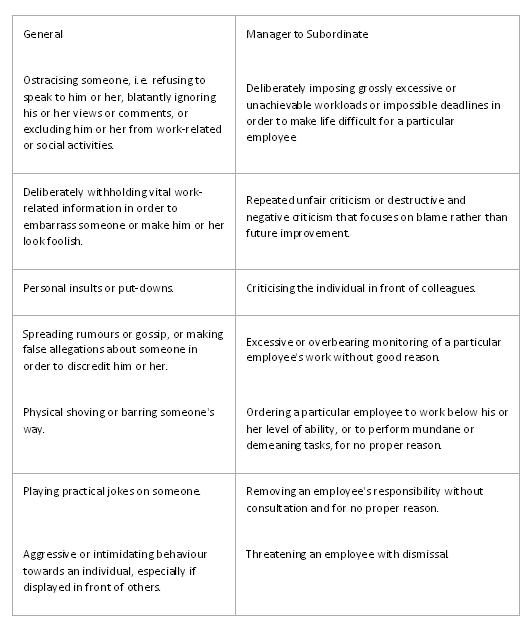The issue of bullying and harassment at work is a serious matter. The CIPD published a study showing that 13% of employees reported having experienced bullying or harassment at work in the previous 12 months. Yet many managers assume that the problem does not exist, often because no one has complained. A belief or assumption that bullying and harassment do not happen is probably the biggest barrier to tackling the problem.
Many employees may be reluctant to report instances of bullying or harassment out of fear of damaging working relationships with their colleagues, fear of reprisals, embarrassment or worry that they may be perceived as troublemakers. It is important for managers to bear in mind that just because no one has complained does not mean that bullying or harassment is not taking place.
Let’s look at what you can do to deal with bullying and prevent it from happening.
What is Bullying?
Bullying at work is behaviour that is:
- threatening, aggressive or intimidating;
- abusive, insulting or offensive;
- cruel or vindictive; or
- humiliating, degrading or demeaning.
Bullying will inevitably erode the victim’s confidence and self-esteem. It normally relates to negative behaviours that are repeated and persistent, and deliberately targeted at a particular individual. It is often an abuse of power, position or knowledge, and may be perpetrated by the victim’s manager, peers or even subordinates.
The following table gives some examples of behaviour that could be perceived as bullying.

What about Harassment?
Harassment is unlawful if it relates to sex, gender reassignment, race (which includes colour, nationality, ethnic or national origins), religion or belief, sexual orientation, disability or age.
The right not to be harassed at work extends to all workers, so agency temps, casual staff and contractors are all protected.
Employees can complain of harassment even if the behaviour in question is not directed at them. This is because the complainant does not actually need to possess the relevant protected characteristic. An employee can complain of unlawful harassment if they have experienced:
- harassment because they are related to or associated with someone who possesses a relevant protected characteristic; or
- harassment by a colleague who has the mistaken perception that they possess a relevant protected characteristic.
For example, an employee could complain of harassment where it relates to the fact that they have a homosexual family member or is wrongly perceived to be homosexual. In addition, harassment could occur where a protected characteristic is used as an excuse for the behaviour, even if the perpetrator does not believe that the employee possess the protected characteristic. For example, a line manager may harass a colleague if he teases him about a learning difficulty, even if he does not have a learning difficulty and the line manager knows that he does not.
It is also unlawful to engage in unwanted behaviour of a sexual nature, or to treat a person less favourably because they have rejected or submitted to unwanted conduct of a sexual nature or unwanted conduct related to sex or gender reassignment.
How Can You Stamp Out Bullying and Harassment?
As an employer you should have and put into effect an anti-bullying/harassment policy. You need to make sure that all your employees know that bullying and harassment at work will not be tolerated and that all instances of such behaviour will be viewed as misconduct, leading to disciplinary action up to and including summary dismissal.
You should also have a well-publicised complaints procedure, to provide a clear route for employees who believe that they are experiencing bullying or harassment at work to raise the matter without fear of recrimination and have it dealt with.
All your managers and supervisors should receive training in how to prevent and deal with bullying and harassment in the workplace. The training should include an overview of the relevant legislation and what it means and the measures needed to deal fairly and effectively with instances of harassment should they occur. Further, all your staff should, ideally, receive basic harassment awareness training.
You should also make a confidential record of any complaints of bullying or harassment that arise. Once a complaint has been effectively dealt with, you must follow up to ensure that working relationships have returned to normal and that no further harassment is taking place.
As with most people issues, the best way to deal with bullying and harassment is straight away. Stamp it out immediately so that it does not escalate into a more serious problem and make it clear to your employees that it will not be tolerated.
If you think you’re being bullied at work, or that bullying is happening in your workplace, please do get in touch with me straight away for a confidential conversation. Call me on 0118 940 3032 or click here to email me.
Source: XpertHR
